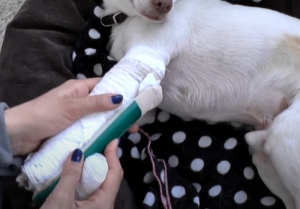PCPR- Lesson 2- Applying a Splint
A splint is a supportive device that protects a broken bone or injury

Step 1- Examine the animal’s wound before attempting to clean it or create a splint. Check if the wound is still actively bleeding or if the blood is mostly dry. If the wound continues to bleed profusely, you need to get the animal to a veterinary specialist as soon as possible. Put on a pair of plastic gloves and gently push aside any hair obscuring the wound. Note the size and depth of the injury. Some broken or fractured bones do not produce any external wound at all, so the lack of blood does not necessarily mean the animal’s leg is not damaged. Step 2- Hold the animal still, or have a helper hold him still if someone is available to help, and gently rinse the wound with water or a light saline solution. Hold the hair around the wound aside if it is in the way. Do not move suddenly or touch the animal’s injury directly, as this may frighten the pet and make them aggressive. Flush the wound with a low-concentration or non-astringent antiseptic. Absorb excess liquid remaining on the wound by dabbing it gently with a clean cloth or gauze.
Step 3- Bandage the animal’s leg by wrapping the cloth strip around it multiple times. Pull it so it lays snug against the animal’s leg without applying pressure to the wound. Layer the bandage by wrapping it around the injured area several times. Wind it around the skin above and below the injury as well. Seal the loose end of the bandage with medical tape to keep it in place.
Step 4- Fit the splint slowly around the animal’s entire leg. For ankle injuries, the splint material should cover the paw, ankle, and knee. If the fracture is further up the leg, then the splint should contain the entire leg up to the joint with the animal’s abdomen. Wrap the splint material around the leg firmly, but not tight enough to apply pressure to the wound. Tape the splint together at the top and the base. Tug gently on the splint to make sure the tape holds.
Step 5- Take the animal to a veterinarian or an animal hospital as soon as you can. A trained specialist with access to advanced equipment, including X-ray machines, can diagnose the problem and develop a solution to fix it. In many cases, the pet will need to continue to wear a splint for several days or weeks until the bone heals. The bandage will need to be replaced regularly for the wound can be cleaned, so you will need to remove and attach the splint at least once a day during the first week or two.
